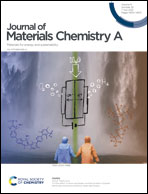High temperature-functioning ceramic-based ionic liquid electrolyte engraved planar HAp/PVP/MnO2@MnCO3 supercapacitors on carbon cloth†
Abstract
In this study, we prepared ceramic-based hydroxyapatite (HAp)/polyvinylpyrrolidone (PVP)/MnO2@MnCO3 composites for high temperature-operable electrolyte-engraved planar supercapacitors. The electrode material was prepared to deposit a composite coating of HAp, PVP, and MnO2@MCO3 on carbon cloth via a one-step hydrothermal technique. The chemical compositions, crystallinity, morphologies, and thermal stability of the resulting composites were investigated by carrying out Fourier transform infrared spectroscopy, X-ray diffraction, X-ray photoelectron spectroscopy (XPS), scanning electron microscopy, and thermogravimetric analyses. The XPS profiles of the composites exhibited Mn 2p1/2 (653.6 eV), Mn 2p3/2 (642.2 eV), N 1s (401.3 eV), and C 1s (285.1 eV) peaks. The planar supercapacitor showed an areal capacitance of ∼84 mF cm−2 and a gravimetric specific capacitance of 409.5 F g−1 with energy density of 56.9 W h kg−1. The supercapacitor exhibited a specific capacitance of 126 F g−1 up to 400 °C. The supercapacitor showed capacity retention of 90% after 100 000 charge–discharge cycles. The supercapacitor prepared in this study was found to be suitable for application in smart electronic devices operating at high temperatures.



 Please wait while we load your content...
Please wait while we load your content...